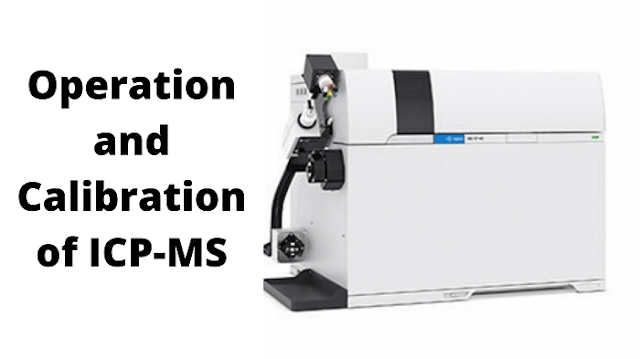This document details the procedure for the operation and calibration of ICP-MS. XYZ Pharmaceuticals Limited's policy is that a written procedure shall be followed for the operation and calibration of ICP-MS.
This procedure is to be applied when operating and calibrating ICP-MS (Inductively coupled plasma mass spectrometry).
RESPONSIBILITY
Persons along with their responsibilities are given below:
Executive – Corporate Quality Assurance:- To prepare the SOP
Trainee Analyst/ Jr. Analyst/ Analyst/ Sr. Analyst:- To follow the SOP accordingly
Manager-Quality Control:- To ensure implementation of SOP
Operation and Calibration of ICP-MS
Check and ensure that:
The
instrument is clean and free from dust. If not, then clean the instrument using a lint-free duster.
Switch
on the blower and recirculate. It will circulate the coolant into the
instrument to minimize the temperature of the instrument.
Before
the plasma ignition, Vacuum pressure should be 10-4 torr.
Open
software.
>Operation and Calibration of GC with FID & ECD
PRECAUTIONS OF ICP-MS
Argon gas cylinders should not
be used below 100 psi in terms of gas quantity.
Release
gas pressure should be between 60-80 psi.
Ensure
that the laboratory temperature is between 20 to 25 C.
Ensure
that the humidity of the laboratory is between 40 to 60 % RH.
MAINTENANCE OF ICP-MS
|
Item |
Frequency |
Procedure |
|
Sample waste container level |
Daily |
Check the level of the waste solution in the
container. |
|
Quartz torch |
Daily |
Visually check the torch condition and measure for proper
alignment. |
|
Peristaltic Pump |
Daily |
Visually check for the acceptable roller pressure,
condition of the sample tubing and the drain tubing, and correct pump
rotation. |
|
Roughing Pump Oil |
Daily |
Visually check the condition and level of the oil. |
|
Sampler and skimmer cones |
Weekly or as necessary |
Visually check the condition of each cone for cleanliness
and proper orifice size. |
|
Filers |
Monthly |
Check and replace as needed. |
|
Pump Oil |
Every 3 months |
Change pump oil. |
|
Detector |
As necessary |
Check and adjust to the proper voltage. |
|
Mist Eliminator |
Monthly |
Visually check the sight glass. It should be clear of oil. |
CLEANING OF
Disconnect
the Instrument from the main power supply.
Clean the
instrument externally with a clean and lint-free cloth daily.
OPERATION
Switch on the blower and
recirculate.
Before the ignition of the plasma,
Vacuum pressure should be 10-4 torr.
Open software.
Open
“Workspace”-------quantitative analysis .wrk.
Open “Method”---“File” ---- Select a file or create a “New File “ according to the requirement.
Set the parameters of analytics.
(If “New File” is being selected)
Feed “Calibration Values” ----
Decide “Report format”.
Analyze ---“Blank” --- “Standard”
---- “Sample”.
If
one wants to check the old data: Go to “Data set” --- Select the row
---“Reprocess report---See”” Summary. report”
Save the calibration curve before shutting down the computer. (The tuning file should not be changed.)
Before switching off “Plasma” ---- Flush with wash
solution at least for 15 minutes so that no memory is left.
Close the software:
Switch off the blower and the recirculated.
Close the gas supply from the cylinder keeping the
flow in the pipeline.
Daily performance check:
The instrument shall be calibrated daily
before analysis.
Daily calibration of instruments and selection of
elements depends upon the sample for analysis on that day.
Linearity for the daily calibration should not be less
than 0.99.
Data of calibration shall be preserved in hard copy
as well as soft copy.
CALIBRATION PROCEDURE (QUARTERLY)
Linearity at Different Concentrations
Dilute the standard solution (Make:
Plasma Cal SCP Science) containing 1000 ppm of arsenic (As), Lead (Pb), Mercury
(Hg), and Cadmium(Cd) in the following way:
1000 ppm 100
ppm
10 ppm
1 ppm 100 ppb
|
|
||||||||||||
Aspirate each concentration i.e. 20 ppb, 10 ppb, 5 ppb, and 2 ppb four times into the instrument.
Acceptance
Criteria:
The concentration mean of each aspiration should be the same as the dilution concentration.
The linearity of different elements of different
concentrations should not be less than 0.99.
PERFORMANCE CHECK ICP-MS (QUARTERLY)
Standardizations of the
instrument are done once a month.
Switch on the blower & recirculate.
Before the ignition of the plasma, the vacuum pressure should be 10-6 torr.
Open Software.
Open “Instrument
“---------Start Plasma
Leave the plasma for 30
minutes or more (minimum 25 minutes).
Open ----“Workspace”
----------“Daily Performance .wrk”
Place the tuning
solution( Make: Setup/Stab/Masscal Solution PE# N8125030.) containing 10 ppb
of Magnesium(Mg), Indium(In), Barium (Ba), Cerium (Ce), and Uranium (U).
Analyze the above solution as a “Sample “.
Do Quarterly Performance Check
Mg intensity > 40,000 cps/10 ppb
In Intensity > 250, 000 cps/10 ppb
U intensity > 200,000 cps/10 ppb
CeO/Ce ;Ba++/Ba < 3 %
Background 220 <2 cps
Observed intensity is acceptable up to 20% below from actual value; if it is below 20% of the above-stated
values then re-optimization is required.
The following parameters should be considered for
re-optimization.
Nebulizer Gas Flow (NEB)
Auxiliary Gas Flow
Plasma Gas Flow
Lens Voltage
Inductively Coupled Plasma Radio-frequency (Rf) power
Analog Stage voltage
Pulse Stage voltage
Quadrupole Rod Offset (QRD)
Cell Path Voltage (CPV)
Click on Get Analyte list
Icon & select Analyte from the Analyte Icon i.e.Mg
Select optimization criteria
& select maximum intensity.
Click on the Optimize icon.
Repeat the steps 7.4.8, 7.4.9
& 7.4.10 for the above-mentioned parameters individually i.e. Nebuliser
Gas Flow, Auxiliary Gas Flow, and Plasma Gas flow
GENERATION OF INSTRUMENT CALIBRATION
NUMBER
Generate the Instrument Calibration number on the calibration datasheet as INSCALXXYYZZZ
Where INS denotes Instrument, CAL denotes Calibration, XX denotes the year, YY
denotes Month ZZZ denotes sequence number.
ABBREVIATION
INS CAL: Instrument
Calibration
RPM: Rotation per
minute
USPRS: United States
Pharmacopoeia Reference Standard
A. R. No. : Analytical report
number
REFERENCE
Working Instructions (Inductively Coupled Plasma Mass
Spectrometer); Issue Date: Jan 2006
Download:- LogBook Format And Apendix


